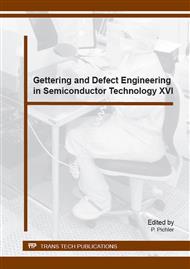[1]
C. W. Zou, X. D. Yan, J. Han, R. Q. Chen, W. Gao, and J. Metson, Study of a nitrogen-doped ZnO film with synchrotron radiation, Appl. Phys. Lett. 94 (2009) 171903.
DOI: 10.1063/1.3125255
Google Scholar
[2]
S. Limpijumnong, X. Li, S-H. Wei and S. B. Zhang, Substitutional diatomic molecules NO, NC, CO, N2, and O2: Their vibrational frequencies and effects on p doping of ZnO, Appl. Phys.
DOI: 10.1063/1.1931823
Google Scholar
[3]
X. Tang, G. Li, and Sh. Zhou, Ultraviolet electroluminescence of light-emitting diodes based on single n-ZnO/p-AlGaN heterojunction nanowires, Nano Lett. 13(2013) 5046-5050.
DOI: 10.1021/nl401941g
Google Scholar
[4]
H. S. Kang, B. D. Ahn, J. H. Kim, G. H. Kim, S. H. Lim, H.W. Chang, and S. Y. Lee, Structural, electrical, and optical properties of p -type ZnO thin films with Ag dopant, Appl. Phys. Lett. 88 (2006)202108.
DOI: 10.1063/1.2203952
Google Scholar
[5]
Y. Zhang, Z. Zhang, B. Lin, Zh. Fu, and J. Xu, Effects of Ag Doping on the Photoluminescence of ZnO Films Grown on Si Substrates, J. Phys. Chem. B 109 (2005) 19200-19203.
DOI: 10.1021/jp0538058
Google Scholar
[6]
M. A. Thomas, W. W. Sun, and J. B. Cui, Mechanism of Ag Doping in ZnO Nanowires by Electrodeposition: Experimental and Theoretical Insights, J. Phys. Chem. C 116, (2012) 6383.
DOI: 10.1021/jp2107457
Google Scholar
[7]
Y. Li, X. Zhao, and W. Fan, Structural, Electronic, and Optical Properties of Ag-Doped ZnO Nanowires: First Principles Study, J. Phys. Chem. C 115 (2011) 3552-3557.
DOI: 10.1021/jp1098816
Google Scholar
[8]
R. S. Zeferino, M. B. Flores, and U. Pal, Photoluminescence and Raman Scattering in Ag-doped ZnO Nanoparticles, J. Appl. Phys. 109 (2011) 014308.
DOI: 10.1063/1.3530631
Google Scholar
[9]
Y. Yan, M. M. Al-Jassim, and S. H. Wei, Doping of ZnO by group-IB elementsAppl. Phys. Lett. 89 (2006)181912.
DOI: 10.1063/1.2378404
Google Scholar
[10]
O. Volnianska, P. Boguslawski, J. Kaczkowski, P. Jakubas, A. Jezierski, and E. Kaminska, Theory of dopingproperties of Ag acceptors in ZnO, Phys. Rev. B 80(2009) 245212.
DOI: 10.1103/physrevb.80.245212
Google Scholar
[11]
A. Shik, Excitons and impurity centers in thin wires and in porous silicon, J. Appl. Phys. 74 (1993) 2951-2953.
DOI: 10.1063/1.354601
Google Scholar
[12]
J. Giblin, F. Vietmeyer, M. P. McDonald, and M. Kuno, Single Nanowire Extinction Spectroscopy, Nano Lett. 11 (2011) 3307-3311.
DOI: 10.1021/nl201679d
Google Scholar
[13]
F. A. Kröger, The Chemistry of Imperfect Crystals, North-HollandPublishing Company, Amsterdam, (1964).
Google Scholar
[14]
A. N. Gruzintsov, V. T. Volkov, I. I. Khodos, T. V. Nikoforova, and M. N. Loval'chuk, Luminescent Properties of ZnO Films Doped with Group-IB Acceptors, Russ. Microelectron. 31 (2002) 200-205.
Google Scholar
[15]
A. M. Gurvich, Introduction to Physical Chemistry of CrystalPhosphors , Vysshaya Shkola, Moscow, 1982 (inRussian).
Google Scholar
[16]
J. A. Portier, H. S. Hilal, I. Saadeddin, S. J. Hwang, M. A. Subramanuan, and G. Gampet, Thermodynamic correlations and band gap calculations in metal oxides, Prog. Solid State Chem. 32 (2004) 207-(2017).
DOI: 10.1016/j.progsolidstchem.2005.05.001
Google Scholar


